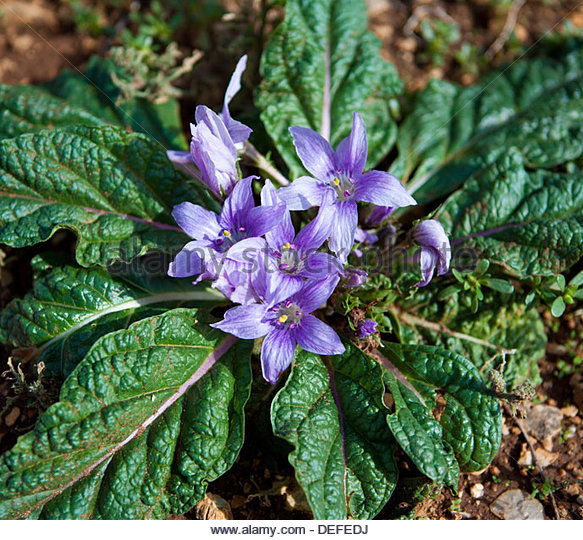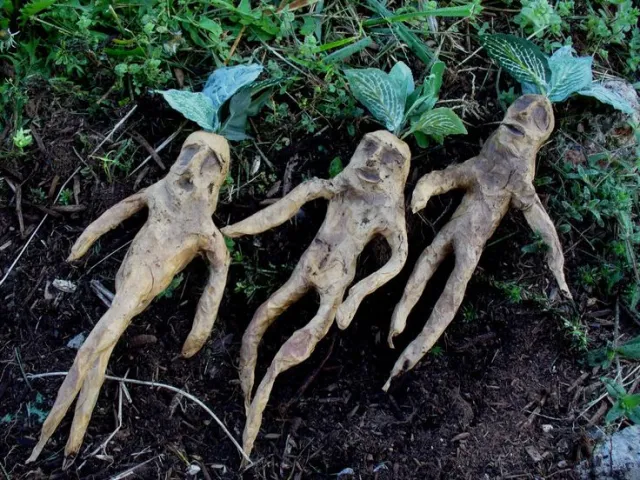General Plant Information:
Mandragora officinarum is also called Satan’s Apple. Mandrake is native to the eastern Mediterranean region. It grows in waste places and abandoned land. It prefers rocky or sandy soil. It grows best in a warm area. There are six species found around this area around the Mediterranean Sea. They are a perennial herbaceous plant. Mandrakes contain hallucinogenic tropane alkaloids. They have been associated with the magical rituals throughout history, as well as in movies, an example of this is in the movie Harry Potter.
Identifiable Characteristics:
They are mostly identified by their human-like root system. However, their leaves and flowers are what shows. Their leaves are ovate and are arranges in a roseete orientation. They have a thin root that is upright. The leaves can grow to be up to a foot in size and between 4-5 inches wide. They often have branches coming off that have bell- shaped flowers with orange and yellow berries. The flowers are star- shaped and berries bloom from autumn to spring (September to April). The fruits are known to have a pleasant scent to them.
Traditional Uses:
The mandrake is centuries old. It has been one of the most important plants in witchcraft, sorcery, and herbal medicine. It appears in the Bible’s book of Genesis to help Rachel conceive Jacob. In Greek mythology, Circe and Aphrodite use it as an aphrodisiac, to stimulate sexual desire. Dioscurides, a famous Greek physician, used mandrake as an anesthetic in ancient Rome. It was mentioned by Dioscurides that if too much is consumed, it could cause you to die.
Since the shape of a mandrake resembles a human figure, it was thought that consuming this could ease ailments of the different body parts. It was thought to take control over the whole body and bring the individual consuming the mandrake love, conception, good fortune, wealth, and power. Women and men often slept with the mandrake under their pillow or carry in their pocket when trying to conceive a baby or secure a lover.
The famous folklore of the screaming mandrake is what was used in Harry Potter and the Chamber of Secrets. The story was that if you dug up a mandrake’s roots, the roots would scream and then the person who dug it up would die. The only way to avoid dying, was to fill your ears with wax, so you could not hear the scream of the root. In addition to this, the digger had to tie a rope between a mandrake root and a dog’s tail, throw the dog a treat, and the mandrake would be pulled out of the ground and kill the dog instead of the human. This was made famous by European witches and sorcerers. They also made the mandrake into potions, ointments, oils, and other concoctions. They thought that using this root brought them children, love, wealth, power, and friends. These concoctions were not used to harm people, but rather to help them.
Modern Day Uses:
The leaves of the mandrake are harmless and cooling. They have been known to be used in ointments and other topical applications. They have been boiled and used as a tea to treat ulcers. In contrast to this, the roots are powerful, emetic, and purgative. These all cause the body to get rid of toxins. In proper dosage, it can be used to help one sleep when they dealing with a prolonged pain. The bark of the root has been infused into some sort of drink, sometimes an alcohol. The properties of the roots and leaves are: sedative, antispasmodic, anti-inflammatory, hypnotic, hallucinogenic, abortive, emetic, and anodine. It can be used to treat jaundice, bilious, infertility issues, fevers, and treating cancer. It has been said to be one of the best herbal treatments for liver diseases, bowel conditions, inflammation, and ulcers. These were all from either steeping or consuming in a capsule one teaspoonful. It noted that one should not take a capsule every day for more than a week.
Important Chemicals:
The chemicals that are active in the mandrake are tropane alkaloids. The specific ones include: scopolamine, hyoscyamine, atropine, and mandragorine. These chemicals have a powerful effect on a humans’ central nervous system.
Dangers:
In large amounts, the mandrake has been known to make people delirious and mad. Too high of a consumption of mandrake can result in death. The safe dosage is very low, so one using mandrake needs to be very careful.
Current Research:
There is not really any emerging research going on regarding the mandrake. The only research I found was scientists realizing how dangerous the toxicity of the roots is. The article I am focusing had an incident of an accidental poisoning after a man ate the berries of the plant. The scientists were looking at a large number of plants, seeds, and berries that had been used for medicinal, psychotropic, or aphrodisiac purposed for thousands of years. A 35- year old man was admitted to the hospital after ingesting the berries of a mandrake because he expressed clinical signs and symptoms of anticholinergic syndrome. His urine was analyzed by toxicologists. His urine showed evidence of hyoscyamine and scopolamine, which are both found in the mandrake berries. He went through decontamination and symptomatic treatment and recovered fully after 4 days of hospitalization.
Sources:
Nicolaou, P, et al. 2011. Accidental poisoning after ingestion of “aphrodisiac” berries: diagnosis of analytical toxicology. J Emerg Med. 6: 662-5.
https://en.wikipedia.org/wiki/Mandragora_officinarum
http://www.botanical.com/botanical/mgmh/m/mandra10.html
http://www.medicinalherbs-4u.com/mandrake.html
Page created by Madeline Maruska


